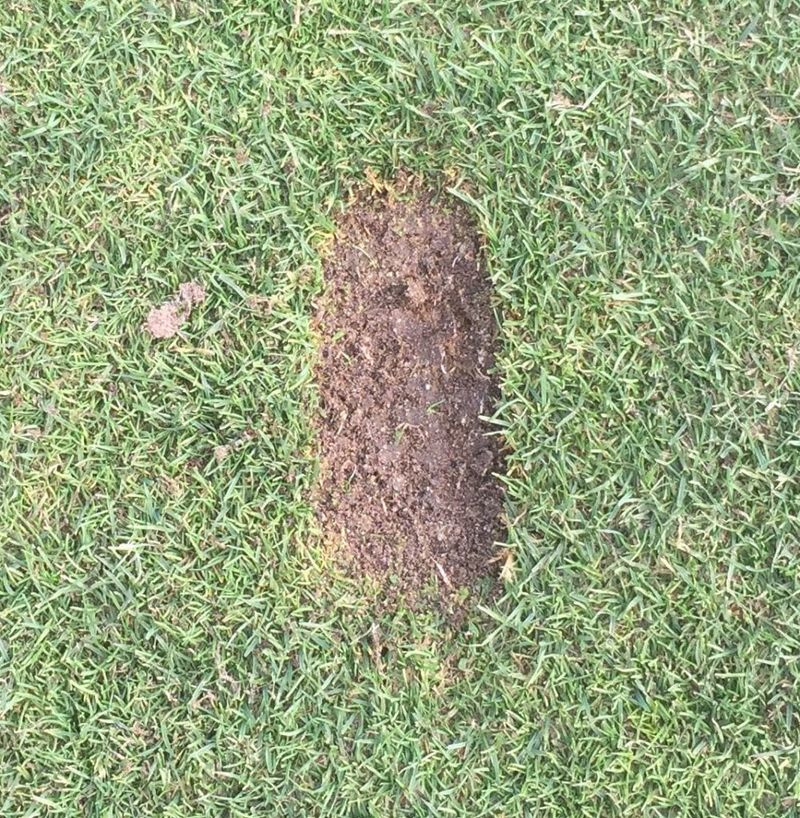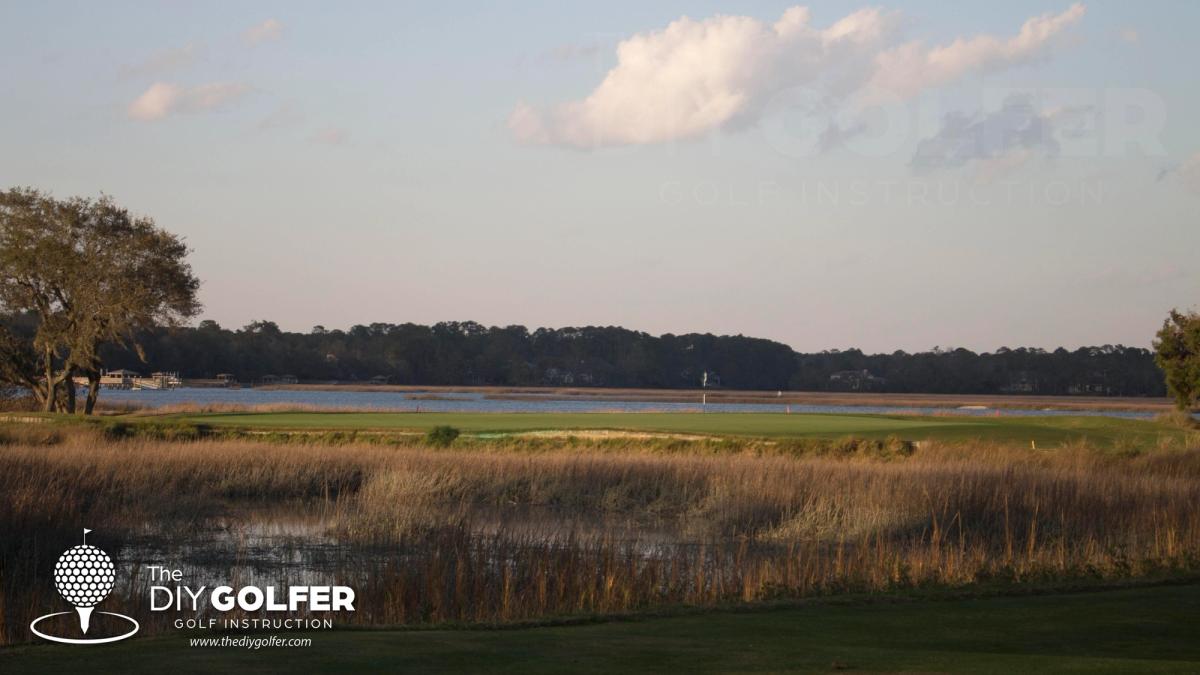If you are in the majority, you probably don’t know what a lie angle is in golf. I hope that by the end of this post, you have a deeper understanding of what a golf club lie angle is, and why it is extremely important for your golf game. After explaining the significance of lie angles, I will show you how to go about changing your own lie angles (if you need it of course).
While learning the game, I can’t say that I knew much about lie angles. I would often see people hitting off of these hard plastic boards during a club fitting, but couldn’t understand why. A bit later in my career, I decided it was time for a club fitting. Once it came time to hit off of the lie board, the fitter put a small piece of tape on the sole of my iron. I hit a ball, and looked at the tape, and there was a mark near the toe of the club. I was told that I needed more “upright” lie angles on my clubs. Little to my knowledge, this would be one of the worst adjustments that I have ever made to my golf clubs.

Before I go into why this adjustment hurt my game, I would like to explain what a lie angle is. (Note: lie angles generally aren't discussed with the Driver or woods because the sole never actually strikes the ground with these clubs). A lie angle is essentially the angle formed between the shaft of the club and the flat ground when the club is soled correctly (sole flush to the ground). I have provided a visual below to further explain this.
A Properly Soled Golf Club
Before getting into any deep discussion about lie angles, one must understand how a golf club should be properly oriented. See the picture below to see the three lie angle orientations at impact:

As mentioned in my post about ball flight laws, when the club does not sit flush with the ground at impact, the club face angle will not point at the target. This is why the ball hooks when on a side-hill above your feet, and fades when the ball is on a side-hill below your feet, even if you strike the ball with a perfectly soled club.
The Ways to Assess Lie Angles
In the golf world, there are three primary ways to see the orientation of the golf club at impact, and thus assess the lie angle.
Lie Board
A common method for determining which of the three orientations the club is at during impact is by using a lie board. A club fitter will place a piece of tape on the sole of an iron (not a driver since it doesn't strike the ground), which will produce a mark depending on which part of the club makes contact with the ground. By looking at where this mark is located, the club fitter can determine what adjustments should be made to the clubs' lie angles.
Divot Patterns
The quickest and easiest way to determine the orientation of your club at impact is by looking at the divot produced on a flat portion of turf. If the divot has a perfectly even depth, and is in a rectangular shape, you are striking the ball with a perfectly soled club. If either the toe or the heel side of the divot is deeper, then, you may need a lie angle adjustment. Below is a photo of a perfectly soled divot pattern:

Launch Monitor
A more modern way to assess lie angle is via launch monitor. I won't be going into depth about this since the majority of those reading this do not have direct access to one of these expensive devices.
Fit Lie Angles to Your Swing, or Your Swing to Lie Angles?
Above are the three ways to determine how your club is oriented at impact, but I do not believe that they properly determine what lie angle is optimal for your swing and body type.
In my post about posture and alignment, I described how a golfer should properly setup to the golf ball. This included a discussion about knee bend, spinal tilt and bend, and weight distribution. These are important to our discussion here because without proper posture, the lengths and lies of your golf clubs become meaningless. If you have perfectly fitted golf clubs, but can't stand over the golf ball with proper posture, the golf clubs will still produce poor results, and will often lead a golfer into thinking that his/her clubs are not fitted correctly. In order to avoid unnecessary equipment adjustments, I can't stress enough how important getting into proper posture is.
If you haven't already realized, determining the correct lie angles for your game is much more complex than hitting a few golf balls off a lie board like we see in modern fittings. The theory says that using a lie board or looking at a divot pattern can adequately assess what adjustment must be made to your golf clubs. This is a rather binary approach to fitting, and many golf professionals have moved away from it as a result. Sure, this approach will tell you what lie angles you need to accommodate your current posture and swing, but this doesn't mean that these lie angles are correct.
For example, let's take a golfer who sets up to the golf ball in a slouched posture, weight on the heels, and during the swing, abruptly "stands up" at impact to compensate for this posture. First off, he/she is most likely setting up too close to the golf ball thanks to the poor posture and incorrect weight distribution. Second off, that "standing up" motion just prior to impact could be causing a steep plane angle through the hitting zone, which will cause a mark on the toe of his/her club while hitting on a lie board. At the end of the fitting, it is determined that this golfer needs to adjust his/her clubs to a more upright lie angle.
The problem with this approach is the fact that this golfer probably doesn't need any adjustment to his/her equipment at all. If he/she would just stand a bit further from the ball with proper posture, this may fix the problem entirely.
Many golfers with similar situations to the one above will have their clubs adjusted, and instead of becoming better, they become worse. With the more upright golf clubs, the golfer will stand even more on the heels, and make an even greater "standing up" motion through impact.
This is why I believe that a golfer should avoid making adjustments to lie angle based on a divot pattern or lie board. Instead, the golfer should first work on posture, and then worry about adjusting the equipment.
That being said, it will be nearly impossible for a 5'0" golfer to setup properly to a golf ball with standard length/lie golf clubs, so there are some considerations to be made based on the golfer's height and arm length.
How to Fit Yourself for Length/Lie
For those golfers just starting out, finding the proper lie angles are less important than finding the proper shaft lengths. Generally, finding the proper shaft length for your body type can be done through a fitting chart, which takes into account a wrist-to-floor measurement, and an overall height measurement. You can check out this page, which has charts for the standard length of golf clubs, as well as a chart for determining the length of your own clubs.
Once you have determined the proper length for your golf clubs, cut/extend them, swing-weight them, and make sure they are at or near standard lie angles. I say standard lie angles because this is generally a good starting point which can be later adjusted.
Now that your golf clubs are the proper length, it is time for some practice! As mentioned earlier, it is useless to adjust lie angles if your posture and/or swing are not functioning consistently and properly. For many, this could mean several months or even years before even thinking about adjusting lie angles.
For those who have a rather consistent golf swing, we can now discuss lie angles in greater detail.
Lie Angles and Swing Type
Once a golfer can set up to the golf ball with proper posture consistently, and can make a fairly consistent swing, lie angles become an important factor to consider.
At this point, making a lie angle adjustment should be based on the intended swing type, depending on how flat/upright the desired swing is.
I often use Bryson DeChambeau as an example on this site, because he represents an extreme case of almost everything in golf. His swing is a one plane swing with a set of clubs that are all the same length. This requires him to swing on a rather steep plane angle with his long irons, and a rather shallow plane angle with his short irons. To accomodate, he has adjusted all of his lie angles to that of a 7-iron. Although most golfers will not have the same lie angles throughout the set, this example illustrates how a golfer can set his lie angles to his intended swing type.
Another good example is Lee Trevino. He was a shorter player with a shallow swing plane angle, and he has been said to play lie angles that are 3 degrees flat of standard.
Finally, look at a guy like Tiger Woods. His swing and body are as standard as standard gets, and he has his lie angles set somewhere around 1 degree flat.
At this point, you might be a bit frustrated that I have left so much ambiguity around this topic, but the truth is, there is no perfect way to fit yourself for lie angles. A lot of this is a result of years of experimentation and practice, and generally doesn't comply with the "theoretical" lie angle rules. A tall player can successfully play with flat lie angles, despite the fact that a modern clubfitter might suggest upright lie angles for this player.
Conclusion
Based on all of this discussion, I think we can come to a few conclusions about lie angles:
- For the better player, lie angles are a huge factor in determining ball flight patterns, while the beginner need not worry about them as much. The more important factor for the beginner is learning the correct posture over the ball, and getting the club lengths correct.
- There are no "rules" that determine what lie angles you should have. It is all relative, and largely based on your build and swing type.
- In most cases, a player should adjust lie angles to their intended swing, rather than their current swing. The only point at which a golfer should adjust lie angles to their current swing is when they have honed their abilities long enough to where they are consistently striking the golf ball flush.
